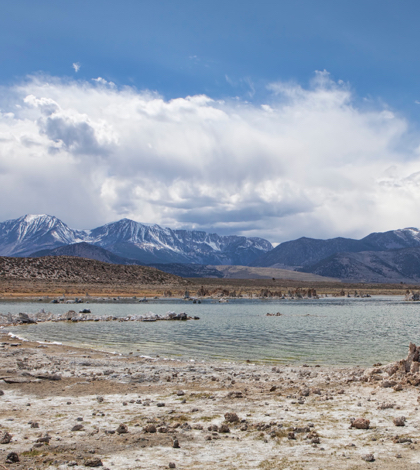California’s on-going drought and water diversions to Los Angeles are taking a toll on not only water levels at Mono Lake but also on the nearly 100 species of birds that annually flock to the lake. The lake currently stands at just 6,378.11 ft., a mere 13 in. above what scientists consider the ecological precipitous.
Mono Lake has dealt with a history of low water levels and ecological issues since the Los Angeles Department of Water and Power (DWP) acquired water rights to the lake’s major streams. In 1941, DWP began diverting four of the streams to the Los Angeles area; by 1974 four-fifths of Mono’s natural stream flow was headed to the state’s largest city. Lake levels in 1941 had already dropped to 6,417 ft.; in 1982 Mono Lake’s elevation was the lowest ever recorded at 6,372 ft.
In 1994 the State Water Resources Control Board restricted exports from Mono Lake to 16,000 acre-feet a year until the lake level elevation reaches 6,392 ft.
The low lake levels have spawned other issues as well. Low lake levels expose more of the shoreline which, in turn, gives rise to more dust storms and decreases air quality. But, for some people, it is the lake’s low level threatening thousands of nesting birds and their fragile ecological balance that is of greatest concern.
Two issues specific issues are of concern for the nesting birds. Mono Lake is one of the world’s most productive ecosystems. The combination of algae, alkali flies and brine shrimp provide a blend of nutrition for dozens of migrating birds including nesting gulls, snowy plovers and eared grebes along with Wilson’s phalaropes who arrive in mid-summer from southern Canada. The production of brine shrimp are affected by the increase in the lake’s salinity and the birds are impacted by the lack of the brine shrimp.
Secondly, with low lake levels, is the threat the lake’s inner islands will become exposed and accessible to coyotes and other animals on the mainland. A passageway to Negit Island, via a pathway along a volcanic flow, nearly became exposed last year. Negit Island is a nesting home to some 50,000 California gulls annually.
Geoff McQuilkin, executive director for the Mono Lake Committee, says, “Increment by increment, this ecosystem is taking a hit from the drought.”
Additionally, winds sweeping off the eastern Sierra Nevada ridge whip up choking dust clouds from the bare soil forcing air quality in the Mono Lakebed one of the worst sources of air pollution in nation. Phillip L. Kiddo, air pollution control officer for the Great Basin Unified Air Pollution Control District, says the best dust control method is snow. But snowfall on both sides of the Sierra Nevada has been scant during the four-year California drought though the increased 2016 snowpack may help.
Originally, water exports from Mono Lake were scheduled to begin on April 1. According to a blog from McQuilkin with the Mono Lake Committee, the “…DWP’s export allotment (for 2016) is currently unknown. It could be zero, or it could be 4,500 acre feet, the same as last year.
“After our attorneys spoke to DWP Attorneys, DWP agreed that exports should not and would not begin on April 1. McQuilkin’s comments continued saying “…the carefully crafted rule that protect Mono Lake while providing water to Los Angeles are being followed. And they are critical because, …the impacts of the drought are far from over at Mono Lake.”
 California Water News Daily Your Source For Water News in California
California Water News Daily Your Source For Water News in California


